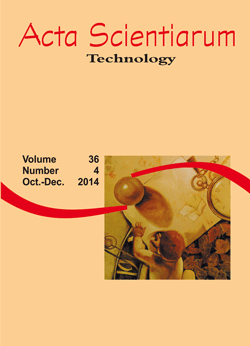<b>Influence of drying temperature on the chemical constituents of jaboticaba (<i>Plinia Jaboticaba</i> (Vell.) Berg) skin
DOI:
https://doi.org/10.4025/actascitechnol.v36i4.19305Palavras-chave:
Plinia jaboticaba, nutrients, bioactive compoundResumo
Jaboticaba is a fruit native to Brazil. Its skin represents up to 43% of the fruit and contains high levels of fiber, minerals and phenolic compounds. The use of the skin waste adds value to the fruit. However, one of the drawbacks of skin storage is the high water content, which requires drying processes to preserve the skin without leading to the loss of nutrients and antioxidants. The influence of different drying temperatures on the levels of nutrients and antioxidants was investigated. Jaboticaba (Plinia jaboticaba (Vell.) Berg, genotype Sabará) skins were lyophilized or dried at three temperatures (30, 45, and 60ºC, using food dryers). The skins were then ground, stored (protected from light) and subjected to analysis of proximate composition, vitamin C, phytate, polyphenols, anthocyanins and antioxidant activity. The drying process had little effect on the proximate composition of the flour, presenting significant difference only for crude protein, fiber and non-nitrogenous extract. The greatest preservation of chemical constituents occurs in the lyophilized jaboticaba skins. Among the drying temperatures tested, however, the skins dried at 45 and60°C had more highly preserved nutritional substances and antioxidants.
Â
Downloads
Downloads
Publicado
Como Citar
Edição
Seção
Licença
DECLARAÇíO DE ORIGINALIDADE E DIREITOS AUTORAIS
Declaro que o presente artigo é original, não tendo sido submetido í publicação em qualquer outro periódico nacional ou internacional, quer seja em parte ou em sua totalidade.
Os direitos autorais pertencem exclusivamente aos autores. Os direitos de licenciamento utilizados pelo periódico é a licença Creative Commons Attribution 4.0 (CC BY 4.0): são permitidos o compartilhamento (cópia e distribuição do material em qualqer meio ou formato) e adaptação (remix, transformação e criação de material a partir do conteúdo assim licenciado para quaisquer fins, inclusive comerciais.
Recomenda-se a leitura desse link para maiores informações sobre o tema: fornecimento de créditos e referências de forma correta, entre outros detalhes cruciais para uso adequado do material licenciado.















